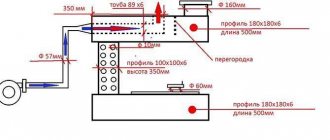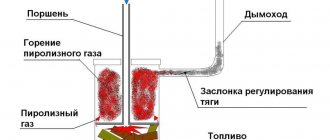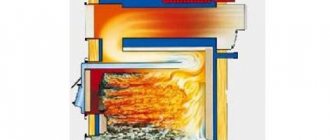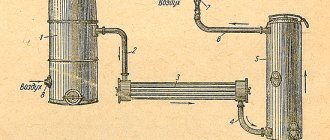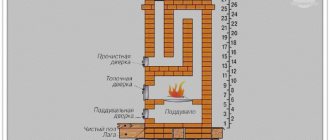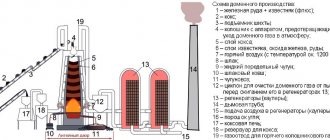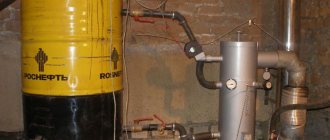When operating any mechanisms, technical oils are used. When used for their intended purpose, they do not burn and remain flammable. Instead of recycling, an alternative option for reusing them is a potbelly stove using waste oil, which you can make yourself.
Let's try to figure out how a potbelly stove works and what materials are needed to make it. We will also talk about popular models of homemade stoves and share the secrets of their successful operation.
Operating principle of a potbelly stove
The operation of a potbelly stove is based on the phenomenon of pyrolysis. Such a furnace, where the fuel is waste oil, has 2 main compartments: a tank and a combustion chamber, located at different levels. The first is intended for pouring waste and burning it.
In another compartment, located above, combustion products of waste mixed with air are burned. At the first stage, the temperature is relatively moderate, and at the second stage it is much higher - up to 800⁰.
When making such a stove, the main task is to ensure that air flows into both compartments. It enters the first chamber through an opening designed for loading liquid fuel. The hole is equipped with a special damper, through which the volume of air supply is regulated.
Despite the fact that the design of the stove is very simple, increased demands are placed on the chimney of a potbelly stove. To effectively remove combustion products, you need to prepare a straight pipe with a diameter of more than 10 cm and a length of more than 400 cm. Bends and horizontal sections are extremely undesirable. In addition to its intended purpose, the pipe also serves as a residual heat exchanger
Air access to the second tank is provided by holes with a diameter of about 9 mm. The efficiency of a properly assembled potbelly stove reaches 90%. Visually, different potbelly stoves may differ from each other in both shape and size, but the principle of operation is the same.
The power of a potbelly stove is proportional to the volume of the lower tank. The larger it is, the less often you will have to add mining. Sometimes this container is made very massive, holding about 30 liters of used oil.
Improving the simple design of the stove during development made it possible to invent a unit for arranging a garage, in which it would be pleasant to wash your hands with hot water, or a small private bathhouse:
Image gallery
Photo from
Enlarged afterburning chamber
Lower chamber in the form of a drawer
Convenient scheme for pouring waste
Practical hot water tank
Homemade wood-burning and waste stove
A simple internal structure and at the same time high thermal efficiency - these are the qualities that distinguish a wood-burning and exhaust stove. The elementary design without complex components allows you to make your own stove from available materials.
Homemade stoves are used for heating warehouses, garages, auto repair shops, etc.
What is better to make a combination stove from?
There are several ways to make a wood-burning stove with your own hands:
- The simplest device made of steel and metal containers (cylinders).
- Models that use forced air injection - turbocharging.
- Drip feed device for mining.
As for furnace equipment with drip feed, it is quite difficult to make it completely safe, calculate productivity and meet other conditions on your own. For this reason, the choice should be made on a homemade universal stove using waste oil and wood with natural and forced air supply.
In the first case, the oven is made exclusively from steel sheets with a thickness of at least 5 mm. It is permissible to use gas cylinders, which are filled with water before cutting to prevent the remaining gas from exploding.
Two closed containers are made from the body of the cylinder, connected to each other by an adapter - a metal pipe, 2-3 mm thick. Holes are drilled in the connector at equal distances from each other.
As a result of assembly, a kind of attachment for mining is obtained, installed on the floor at one end, and the other is built into the firebox of a solid fuel furnace. Homemade universal stoves using waste oil, wood, sawdust and garbage, with built-in water heating, are equipped with an aluminum or copper coil.
A slightly more complicated device is one with a built-in fan that forces air currents to burn waste. Some users install a fan next to the stove, directing the air flow into the ash pan.
Combined type stove for firewood and mining
A universal metal furnace for working and wood burning has a device in which oil is supplied from above, and firewood is laid from below. In the process of burning solid fuels, the principle of top combustion is used.
The design of the furnace has the following features:
- Convective channels – wood-burning stove, hot air stove. The room is heated by radiation from the heated metal walls. To increase thermal efficiency, several pieces of pipe are welded onto the body. This is how the simplest air heating device appears, using the principle of convection heating.
- A water jacket is a self-made stove using wood and waste oil with a water circuit that allows you to heat not only the room with the installed heater, but also adjacent rooms. A simple coil is installed inside the housing. A piece of curved pipe of the appropriate diameter will do. For better heat transfer, a copper or aluminum coil is used. The heat sink is installed so as to avoid direct contact with fire. Heating is carried out through heated flue gases.
- Firebox - regardless of what you plan to use to heat the furnace, use an attachment for mining or firewood, the principle of pyrolysis combustion is applied. First, the fuel itself is burned, and then the exhaust gases are burned. For this purpose, the design includes two combustion chambers.
In furnaces with natural air supply and exhaust, special nozzles are used inside the housing to ensure the necessary oxygen flow.
How to convert a wood stove for mining
Converting a wood stove to use used engine oil does not require changing the internal structure or design of the heater. As a rule, a special attachment for testing is made for this purpose, consisting of the following components:
- The primary combustion chamber is actually a waste pan, with the simplest purpose of storing fuel and providing sufficient evaporating surface area necessary for burning the oil.
- The hole for the fuel supply is on the side of the made fuel receiver; a piece of small diameter pipe is welded. The mining will be poured through the hole and set on fire.
- Secondary combustion chamber - there is no full-fledged combustion chamber in the device for burning waste. The afterburner is a curved pipe of sufficient diameter connected to a pan. Injection holes are made along the entire length - nozzles for the supply of air necessary for secondary combustion during pyrolysis.
- Protective casing - when upgrading a wood-burning stove for used oil, it is taken into account that the main heating will be carried out by the steel walls of the stove, and not by the oil burner or attachment. For this reason, the pipe extending from the pan is bent so that it is approximately in the center of the open door of the solid fuel heater. A steel casing is welded along the edges to the size of the firebox of a wood-burning stove, preventing smoke from entering the room.
Modifying the furnace to use oil is not difficult and requires minimal financial investment.
How to use oil in a wood stove
An all-in-one stove that runs on both waste oil and wood requires proper operation and the ability to refuel and ignite liquid fuel. Precautionary measures are especially necessary when operating homemade stoves.
Refueling and ignition are performed as follows:
- You can add used oil to the oven through a special hole with a pipe located on the attachment, specially made with a small diameter. Refueling is allowed while the fuel is burning. The tray is filled ⅔ full.
- Ignition - sawdust mixed with waste oil is used to light the fuel. If the exhaust is cold, after refueling, add flammable liquid to the fuel receiver. Ignition is performed using paper rolled into a tube.
After the oil flares up, as evidenced by a uniform hum, the stove is switched to the long-burning mode, closing the slide valve.
Making a potbelly stove from a gas cylinder
Another design option for a waste furnace is a self-made potbelly stove based on a 50-liter gas cylinder. In addition to this main element, you need to prepare 2 steel pipes with a wall of about 4 mm and a diameter of 10 cm. One of them will remove burning gases, and the second will act as a heat exchanger.
To this should be added a 4 mm steel sheet for the hood above the heat exchanger and the partition separating the evaporator and the combustion chamber. For the evaporation chamber itself, you will need a brake disc from a car with such a diameter that it fits into the cylinder without effort. A piece of 0.5-inch pipe is needed to transport oil to the combustion chamber.
A used cylinder makes an excellent potbelly stove. Although there is no gas in it, it is better to play it safe - keep the cylinder outside for a while with the valve open. Soap suds are applied around the outlet hole. When it stops bubbling, the valve is twisted, if it is removable; if not, the condensate is drained in another way
In addition, you should have in stock an equilateral steel angle with a shelf of 50 mm and a length of more than 1 m, a 0.5-inch valve, clamps for sealing - 2 pcs., a hose, any cylinder equipped with a needle valve.
The work of creating a potbelly stove is carried out in a certain order. First, the container is turned upside down and a small hole is drilled in it. A measure such as wetting the drill and the drilling site with oil will prevent sparking.
The valve is dismantled using a gas or adjustable wrench. After freeing the vessel from all residues, it can be cut and welded
Empty the container from gas condensate. Drain it carefully away from your home, because... its unpleasant odor lingers for a long time. Then the workpiece is filled with water, after which it is drained again, thus removing any remaining gas. Since the mixture is explosive, there should be no open flame nearby.
Cut out 2 rectangles of the same width in the cylinder body, equal to 1/3 of the diameter of the workpiece. The height of the lower rectangle is 20 cm, the second, located 5 cm above the first, is 40 cm. To separate the chambers, a circle with a diameter equal to the internal diameter of the vessel is cut out of a sheet.
In its middle, a hole is made for a pipe with a diameter of 10 cm. This part will separate the combustion chamber from the heat exchanger.
A burner is made from a pipe 20 cm long and 10 cm in diameter. Its lower part is perforated by making holes with a diameter of about 2 cm. The inside is cleaned of burrs, otherwise they will collect soot on themselves, which will significantly narrow the hole later.
Place the previously cut circle on the burner, placing it exactly in the middle, and weld it. The structure is placed inside the stove and a weld is made around the circumference of the cylinder.
Weld the bottom and cover onto the brake disc. This will be the evaporator pan or bowl. To supply fuel, an opening is left in the lid through which air will flow into the stove. The opening is made quite wide, otherwise the draft will decrease and the oil will not get into the bowl.
Weld the pipe onto the top of the lid. A coupling is made from a pipe with a diameter of 10 cm that will connect the bowl to the burner.
Assemble the fuel supply system, for which:
- make a receiving hole in the pan;
- insert a 0.5-inch piece of water pipe into it at an angle of about 40⁰;
- weld the pipe to the furnace body;
- screw an emergency backup valve to the pipe, the role of which is played by an ordinary water tap.
A heat exchanger is made from a pipe with a cross-section of 10 cm. It is cut horizontally into the body of the potbelly stove, and a reflector is mounted at the end. Inflating is achieved by installing a duct fan at the end of the heat exchanger. The air driven through the heat exchanger with its help has a high speed.
In order to make the system more controllable, it is automated by connecting a thermal relay to a duct fan. This solution allows you to set the required temperature
An air swirler consisting of triangular teeth connected by welding is placed inside the heat exchanger. A chimney is made from a pipe with a cross-section of 10 cm.
It is welded into a hole located in the upper part of the furnace body and brought out through the wall to the roof of the building.
It is better to place the section of pipe passing through the enclosing structure in a fireproof glass, and attach a metal sheet at the entrance point
Next they are making the oil tank. If you have a freon-free cylinder with a working needle valve, then it is quite suitable for this purpose. The vessel and the potbelly stove are connected with a hose connected to the valve. To fill the used oil, a hole is made in the tank body.
To ensure air access to the burner and the evaporator bowl, a groove is selected in the door of the lower compartment. Thrust plates are attached to the upper chamber door opening, which ensures reliable sealing of the combustion chamber. For the same purpose, the door is additionally equipped with a lock.
Now, even if the potbelly stove body is deformed as a result of strong heating, the tightness of the combustion chamber will not be compromised.
All that remains is to weld the legs from the angle pieces to the body and place the stove vertically. In addition to vertical potbelly stoves, horizontal stoves are also made from cylinders. Their structure is similar.
Furnace in production - what's what
To begin with, we will tell you what such a unit, assembled with your own hands, is, and why it is used at all. In winter, the room needs to be heated; it just so happens that electricity is quite expensive. Plus, you need to buy expensive equipment . To save money, craftsmen came up with a way to heat fairly large rooms using a small homemade stove.
The fuel used is oil, the cost of which currently does not exceed
15-20 rubles per liter.
You can buy it in many places, but such products are not officially sold (in appropriate packaging on store shelves). The waste burns for a long time, releasing a large amount of heat - you can heat a room of up to 100 square meters, spending no more than a hundred rubles for the whole day. Ignition can be done using gasoline , diesel fuel or even solvent. All this will burn out in just a few minutes, giving rise to the burning of oil. Remember that you should not add oil to a working oven - it is dangerous. It’s better to put it out, add oil, and then re-ignite it (this does not apply to “drip” options, which are equipped with an automatic fuel supply mechanism).
Potbelly stove plus water circuit
Any home could benefit from having an emergency heat source. Its role can be played by an ordinary, but slightly modernized, potbelly stove. You can improve the stove in two ways - put a water jacket on the burner pipe or wrap its body with a coil of copper tubes.
The coil turns are placed at a distance of about 5 cm from the perforated body of the potbelly stove and connected to the general heating system. A reflective screen is installed around the coil. For its manufacture, sheet aluminum, galvanized steel, and tin are used.
The water jacket is a tank on the upper chamber of the potbelly stove. There should be 2 fittings in its body - one for water supply and the other for drainage. In general, the design resembles a samovar. The volume of the water jacket depends on the length of the heating system and the method of circulation of the coolant.
In practice, the issue of constructing a water circuit is solved by installing a container directly on the potbelly stove. Hot water enters the heating system through the outlet. After going around the circle, it radiates heat into the room and returns back to the container.
If a pump is built into the system, the volume of the tank is small, but with natural circulation it has impressive dimensions. To control water parameters, a pressure gauge and thermometer are installed on the tank.
Drip potbelly stove under development
You can also make an economical model of a drip stove yourself. For the body, a small metal barrel or another container available on the farm is suitable. A hole is made in the housing through which oil will flow.
Next, take a burner with a capacity of about 2 liters, connect a 1 m long copper tube to its hose, and then fold it in half.
Such a unit, operating on waste petroleum products, can smoke, so the room in which it is installed must have good ventilation
A hole is made in the container along the diameter of the tube. The tube itself is shaped like the letter “L”, and the burner is suspended.
Conversion of a solid fuel stove for testing
When the household already has a potbelly stove, but is not happy with the fact that it runs on solid fuel, you can modernize it and it will become universal. For this purpose, an attachment is made that resembles in its design a stove with processing in its lower part.
There is also a perforated pipe here, but not straight, but bent at a right angle. It is connected to the side wall of the furnace, which serves as the final combustion chamber. If you weld the potbelly stove door and make a hole in it for the pipe to enter, then the stove will only work during exhaust.
The modernization of this stove consists not only of adding a special attachment to it, but also of an original solution to protect nearby objects from fire using the principle of convection. For this purpose, pipes were welded to the side wall of the furnace. Cold air entering them from below cools the structure
To make it possible to use not only industrial oil for heating, but also firewood, two replaceable doors are made. The standard one is hung when it is planned to lay firewood, and the modernized one with the appropriate hole is hung when the stove will operate on waste oil.
We also suggest reading an article on how to assemble a potbelly stove using waste oil from a pipe - to familiarize yourself with the material, follow the link.
Advantages and disadvantages of the stove during mining
Furnace in operation with a dispenser.
Processing furnaces have many advantages compared to other mechanisms:
- cheap fuel;
- low fire hazard;
- independence of the furnace operation from weather conditions;
- fast heating of small rooms;
- used for cooking.
However, this stove also has disadvantages:
- a chimney is required;
- the stove gets very dirty, so it and the chimney need to be cleaned once a year, depending on the frequency of use;
- The oil must be cleared of water, since boiling in the tank can lead to splashing of the burning oil.
Secrets of successful operation of a potbelly stove
In order for a potbelly stove running on waste oil to be effective and safe, you need to follow a few tips. The oil must settle before use. You need to fill it into the oil tank to 2/3 of its volume.
For safety reasons, all elements of the stove should be cleaned regularly. To simplify this task, its top module should be removable. This will provide access to the chamber where the combustion of the mixture occurs. To remove soot from the walls of the chimney, it should be tapped.
To extend the service life of the combustion chamber and the furnace as a whole, it must be painted using paints that are resistant to high temperatures. The potbelly stove should be installed on a non-combustible base. Do not place it in a draft, under the influence of which a flame could escape.
Homemade oil furnace being tested: operating principle and characteristics, how to make it yourself
An exhaust furnace can be used for heating garages, workshops, and various utility rooms. This makes it possible to save significant amounts of money using waste material for heating. There are many diagrams and drawings of a stove being tested, following which you can assemble a high-quality device with your own hands. For the firebox, used machine oil or any other oil with flammability properties is used.
Operating principle of the stove
Oil stoves work using waste heated to a certain temperature. At high temperatures, it breaks down into components, part of which are flammable mixtures. When burned in a fire, they release a large amount of thermal energy. Oxygen must be present in this process.
Waste oil is heavy, dirty oil that has been used. This oil hardly burns. Therefore, it needs to be subjected to a splitting process. There are two ways: using oxygen, that is, oxidation, or heating. The first method is excluded, since it cannot be used in domestic conditions.
The second, simplest option is the combustion of the fuel itself, during which splitting (pyrolysis) occurs. But before starting the process, the mining should be heated to +400 degrees. It will begin to release flammable vapors, that is, to split.
Thus, it will not be difficult to make your own heating device that runs on oil. Essentially, this is a reservoir in which the waste is heated. This is where pyrolysis processes occur. The design feature of the homemade apparatus is a pipe in which the holes are arranged in a checkerboard pattern. It is along it that flammable vapors rise , and an influx of air enters through the holes, enriching the vapors with oxygen.
This mixture, when burned in the upper chamber, releases thermal energy.
Disadvantages of burning waste oil
Typically, this type of furnace is installed in garages during mining. But the design has some disadvantages:
- the device operates with an open flame and is a fire hazard, especially if there are petroleum products in the room;
- low power (not higher than 15 kW);
- inability to stop the fuel combustion process;
- A fire can only be extinguished with a carbon dioxide fire extinguisher; a powder extinguisher causes explosions on hot metal.
Therefore, this design cannot be assembled using fasteners. When making a homemade waste oil furnace, only welding work can be used.


